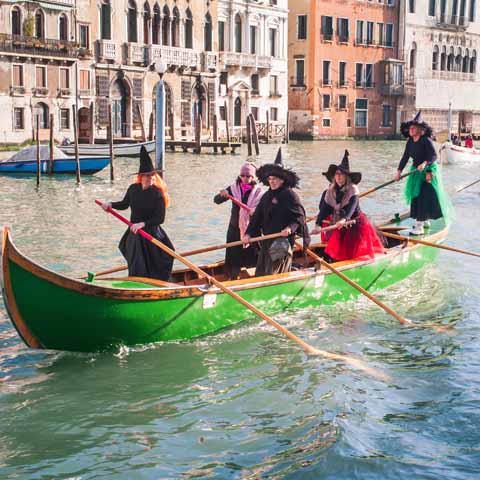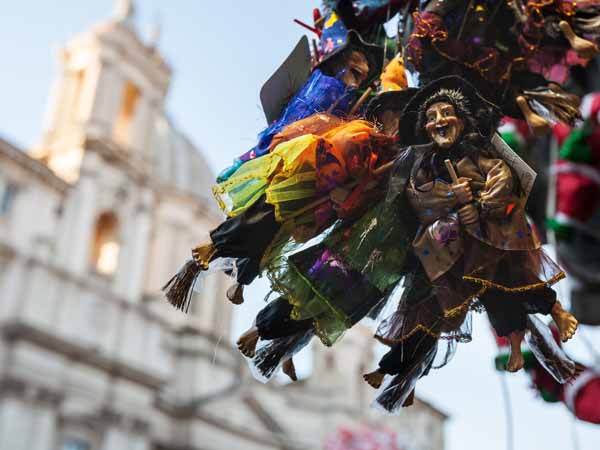
While Christmas might be more famous worldwide, Italian children have another special holiday to look forward to in early January. On the night of January 5, the eve of the Epiphany, an old woman riding a broomstick is said to deliver gifts to good children throughout Italy. Though elements of this story might sound familiar, La Befana is uniquely Italian.
Italy's La Befana Celebration
The Feast of the Epiphany
January 6 marks the Feast of the Epiphany, a well-established religious celebration and a national holiday in Italy. Traditionally, the Feast of the Epiphany is a celebration of the arrival of the 3 Wise Men (or 3 Magi) who brought gifts to the newborn Baby Jesus. For Italians, the Epiphany officially marks the end of the Christmas holiday season. And, for Italian children, the morning of January 6 offers one last opportunity to receive sweet treats before the season ends.
Who is La Befana?
According to a legend dating back to the 12th century, the 3 Wise Men invited La Befana to join them in bringing gifts to Baby Jesus, but she did not accept. Eventually, Le Befana regretted her decision, but was unable to catch up to the 3 Wise Men or find the manger on her own. As a result, she decided to give small gifts to every child she came across in hopes that one of them might be Baby Jesus.
The tradition continues, and each year on the evening of January 5 La Befana departs on her broomstick and visits every Italian household that has a child. Children throughout Italy anxiously leave out a shoe or hang a stocking in hopes of receiving candy or a small toy from La Befana, who comes down the chimney or flies in through a window. If a child did not behave well during the year, traditionally La Befana leaves a lump of coal. However, everyone deserves a second chance and many Italian shops sell “carbone” candy, which is made to look like coal, as a fun treat for children.
Urbania: Home of La Befana
When she’s not delivering candy to children, La Befana is said to reside near Urbania, a tranquil town tucked away among the gentle hills of the Marche region. Naturally, from January 4 to 6 each year, Urbania transforms into a wonderland to celebrate its most famous resident. During this time, local children hang more than 4,000 stockings along the streets of the town center, while the adults decorate buildings with lights. The locals also celebrate with street markets, concerts, and other live performances.
There are plenty of activities for children of all ages to enjoy including a festive playground and creative workshops featuring ceramics (a traditional craft that Urbania has long been known for). Parents can partake in tastings of local products, such as crostoli (fried pastries), and wine. Families can also join walking tours of the town’s historic monuments, such as the Ducal Palace, the Bramante Theater, and the Church of the Dead, lead by none other than La Befana herself!
In 2016, Urbania even created a House of La Befana in the town hall. The attraction is open year-round with La Befana eager to welcome children from all over Italy. La Befana shows children how to make “carbone” candy, weave fabric with a loom, and tells captivating stories about Urbania, a land rich in culture and traditions. During the days leading up to the celebration of La Befana, a Befana Postal Office is set up in the town hall where children can mail letters to the kind old woman.
La Befana vien di notte
Italian children also celebrate La Befana with a short nursery rhyme that lives on in their memory long after reaching adulthood. Several variations are well-known throughout the country, but among the most popular versions is:
La Befana vien di notte
con le scarpe tutte rotte
con le toppe alla sottana/con vestito alla romana
viva viva la Befana!
This translates to:
La Befana comes by night
with her shoes all torn
with patches on her skirt/ (alternative verse) dressed in the Roman way
hooray hooray for la Befana!


The legend of La Befana is one of the most celebrated examples of Italian folklore. While Italian children also cherish the arrival of Santa Claus (Babbo Natale) on Christmas, La Befana holds a special place in their hearts, bringing plenty of cheer and joy to ensure everyone has the chance to start the new year right.
